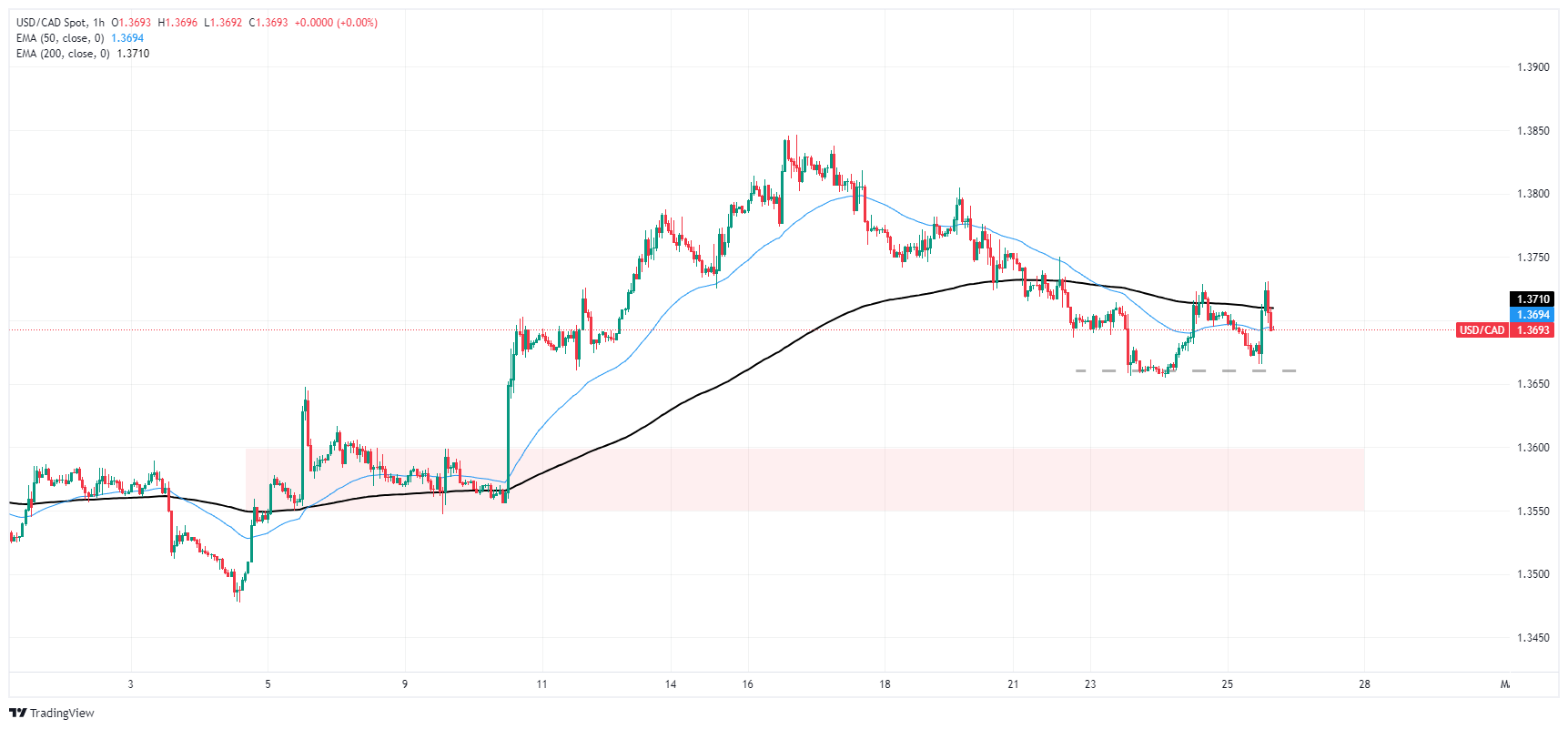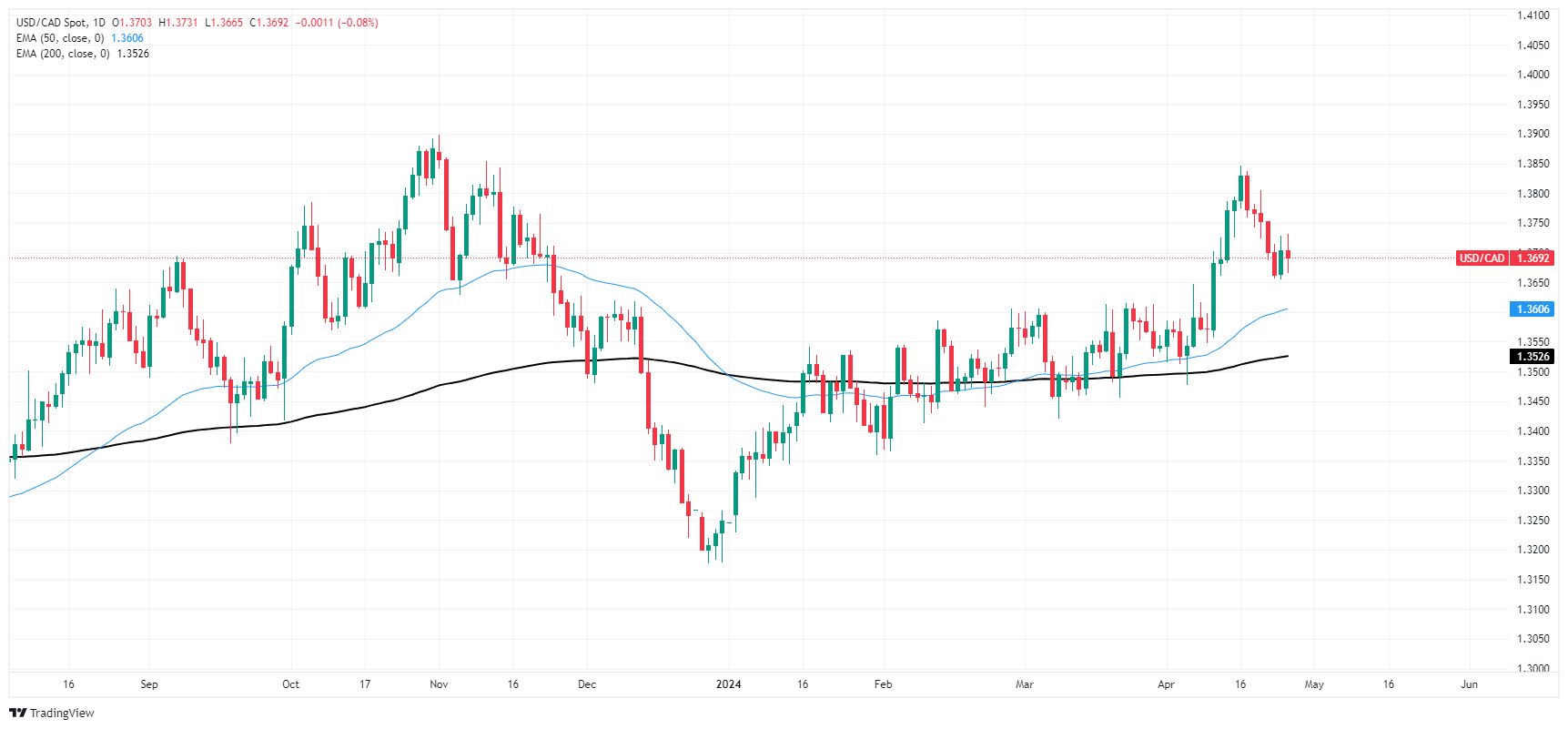- Canadian Dollar is stuck near familiar levels, giving mixed performance.
- Canada will not provide data this week. Next week it will publish its GDP.
- The US GDP showed weak figures, but the PCE suggests that inflation remains high.
The Canadian Dollar (CAD) was mixed on Thursday and remained close to known technical levels after US data was released in both directions early in the session. The US Gross Domestic Product (GDP) fell more than expected, which benefited investors expecting rate cuts from the Federal Reserve (Fed). However, inflation remains a major stumbling block to rate cut hopes, after US Personal Consumption Expenditure (PCE) inflation rose even more than expected.
Canada will be absent from the economic calendar for the rest of the week. The next data of interest will be the Canadian monthly GDP for February, which will be published on Tuesday. Canada's Global Manufacturing Purchasing Managers' Index (PMI) will also be released on Wednesday.
Daily Market Moves Summary: US Dollar loses momentum after US data fails to paint clear picture
- Annualized US GDP for the first quarter fell to 1.6%, down from 3.4% previously and well below the 2.5% forecast.
- The rapid slowdown in GDP is good news for investors desperate for the Fed to lower rates. However, US PCE inflation in the first quarter rose to 3.7%, beating forecasts of 3.4% and accelerating from 2.0% previously.
- Rising inflation will keep the Fed struggling to cut rates, markets agitated by mixed data.
- Friday's US PCE price index will attract more attention after Thursday's dismal indicator.
- The US monthly PCE price index for March is expected to remain stable at 0.3%, while the annual figure would decline to 2.6% from 2.8% previously.
Price of the Canadian Dollar today
Below is the percentage change of the Canadian Dollar (CAD) against the currencies listed today. The Canadian Dollar appreciated against the Japanese Yen.
| USD | EUR | GBP | CAD | AUD | JPY | NZD | CHF | |
| USD | -0.15% | -0.24% | -0.06% | -0.10% | 0.22% | 0.00% | -0.04% | |
| EUR | 0.17% | -0.05% | 0.11% | 0.07% | 0.39% | 0.16% | 0.13% | |
| GBP | 0.23% | 0.08% | 0.17% | 0.15% | 0.47% | 0.21% | 0.20% | |
| CAD | 0.11% | -0.06% | -0.13% | -0.01% | 0.30% | 0.09% | 0.05% | |
| AUD | 0.10% | -0.05% | -0.12% | 0.04% | 0.31% | 0.09% | 0.06% | |
| JPY | -0.21% | -0.35% | -0.44% | -0.28% | -0.31% | -0.22% | -0.26% | |
| NZD | 0.04% | -0.12% | -0.20% | -0.04% | -0.07% | 0.25% | 0.02% | |
| CHF | 0.04% | -0.12% | -0.20% | -0.04% | -0.05% | 0.28% | 0.01% |
The heat map shows the percentage changes of the major currencies against each other. The base currency is chosen in the left column, while the quote currency is chosen in the top row. For example, if you choose the Euro in the left column and scroll down the horizontal line to the Japanese Yen, the percentage change that appears in the box will represent EUR (base)/JPY (quote).
Technical analysis: The Canadian dollar is trading stable but mixed
The Canadian Dollar (CAD) is being pushed towards the center on Thursday, trading flat to within a quarter of a percentage point across major currency boards during the US market session. Against the US Dollar (USD ), the CAD advanced just one tenth. The Japanese Yen (JPY) fell a quarter of a percentage point against the Canadian Dollar, making it the worst performing currency of the day.
The CAD continues to trade within a tight range near the 1.3700 level against the US Dollar, and the USD/CAD has set a near-term low near 1.3660. A bullish breakout is hampered by the 200 hourly EMA at 1.3710, and a heavy supply zone rests just below the current price action below 1.3600.
USD/CAD hourly chart
USD/CAD daily chart
Frequently Asked Questions about the Canadian Dollar
What factors determine the price of the Canadian dollar?
The key factors that determine the price of the Canadian dollar (CAD) are the level of interest rates set by the Bank of Canada (BoC), the price of oil, Canada's main export product, the health of its economy, inflation and the trade balance, which is the difference between the value of Canadian exports and its imports. Other factors are market confidence, that is, whether investors bet on riskier assets (risk-on) or look for safe assets (risk-off), with the risk-on being positive for the CAD. As its largest trading partner, the health of the US economy is also a key factor influencing the Canadian dollar.
How do Bank of Canada decisions affect the Canadian dollar?
The Bank of Canada (BoC) exerts significant influence over the Canadian Dollar by setting the level of interest rates that banks can lend to each other. This influences the level of interest rates for everyone. The BoC's main objective is to keep inflation between 1% and 3% by adjusting interest rates up or down. Relatively high interest rates are usually positive for the CAD. The Bank of Canada can also use quantitative easing and tightening to influence credit conditions, with the former being negative for the CAD and the latter being positive for the CAD.
How does the price of oil affect the Canadian dollar?
The price of oil is a key factor influencing the value of the Canadian Dollar. Oil is Canada's largest export, so the price of oil tends to have an immediate impact on the value of the CAD. Generally, if the price of oil rises, the CAD also rises, as aggregate demand for the currency increases. The opposite occurs if the price of oil falls. Higher oil prices also tend to lead to a higher probability of a positive trade balance, which also supports the CAD.
How does inflation data influence the value of the Canadian Dollar?
Although inflation has traditionally always been considered a negative factor for a currency, as it reduces the value of money, the opposite has actually happened in modern times, with the relaxation of cross-border capital controls. Higher inflation often leads central banks to raise interest rates, attracting more capital inflows from global investors looking for a lucrative place to store their money. This increases the demand for the local currency, which in the case of Canada is the Canadian Dollar.
How does economic data influence the value of the Canadian dollar?
The published macroeconomic data measures the health of the economy and may have an impact on the Canadian dollar. Indicators such as GDP, manufacturing and services PMIs, employment and consumer confidence surveys can influence the direction of the CAD. A strong economy is good for the Canadian dollar. Not only does it attract more foreign investment, but it may encourage the Bank of Canada to raise interest rates, resulting in a stronger currency. However, if economic data is weak, the CAD is likely to fall.
Source: Fx Street
I am Joshua Winder, a senior-level journalist and editor at World Stock Market. I specialize in covering news related to the stock market and economic trends. With more than 8 years of experience in this field, I have become an expert in financial reporting.







